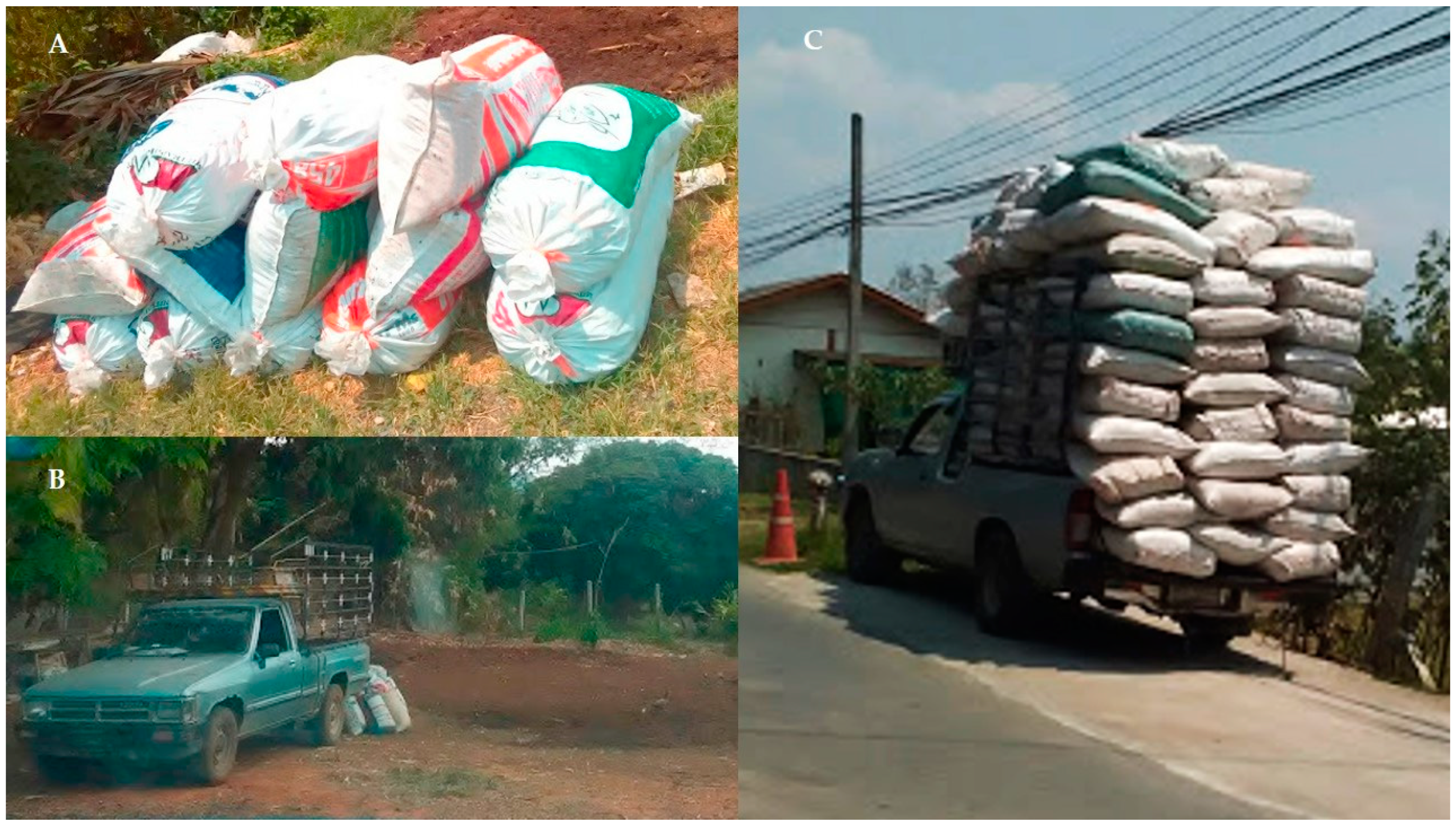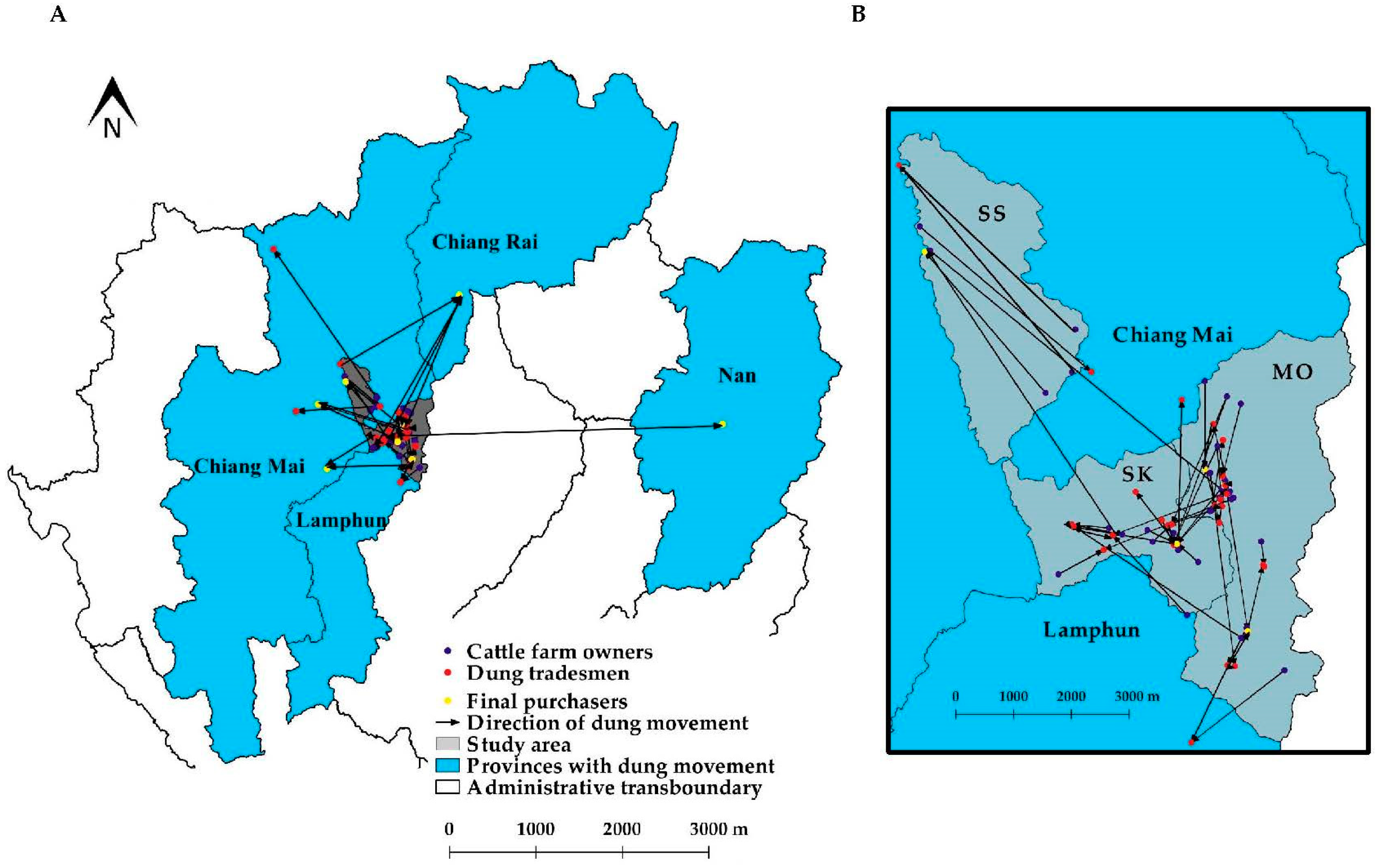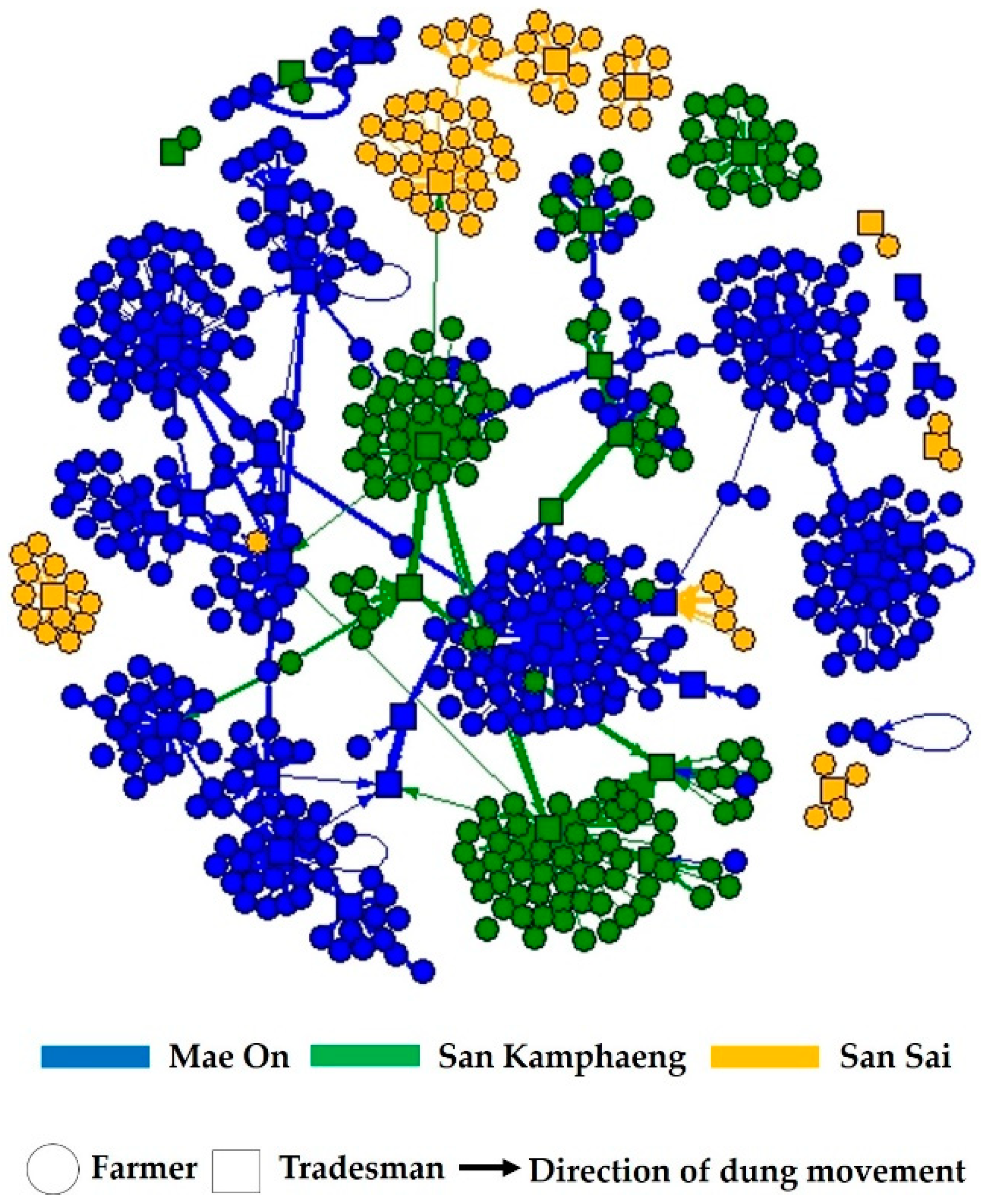Cattle Manure Trade Network Analysis and the Relevant Spatial Pathways in an Endemic Area of Foot and Mouth Disease in Northern Thailand
Abstract
1. Introduction
2. Materials and Methods
2.1. Study Area
2.2. Data Sources
2.3. Questionnaire Survey
2.4. Statistical Analysis
3. Results
3.1. Description of Respondents
3.2. Manure Trading, Transportation and Bio-Security
3.3. Movement Pathway of Manure Transportation
3.4. Characterization of Manure Trade Network
4. Discussion
5. Conclusions
Supplementary Materials
Author Contributions
Funding
Acknowledgments
Conflicts of Interest
Ethics Statement
References
- Thompson, D.K.; Muriel, P.; Russell, D.; Osborne, P.; Bromley, A.; Rowland, M.; Creigh-Tyte, S.; Brown, C. Economic Costs of the Foot and Mouth Disease Outbreak in the United Kingdom in 2001. Rev. Sci. Tech. 2002, 21, 675–687. [Google Scholar] [CrossRef] [PubMed]
- Knight-Jones, T.J.D.; Rushton, J. The Economic Impacts of Foot and Mouth Disease—What Are They, How Big Are They and Where Do They Occur? Prev. Vet. Med. 2013, 112, 161–173. [Google Scholar] [CrossRef] [PubMed]
- Nampanya, S.; Khounsy, S.; Abila, R.; Young, J.R.; Bush, R.D.; Windsor, P.A. Financial Impacts of Foot-and-Mouth Disease at Village and National Levels in Lao PDR. Transbound. Emerg. Dis. 2016, 63, e403–e411. [Google Scholar] [CrossRef] [PubMed]
- Madin, B. An Evaluation of Foot-and-Mouth Disease Outbreak Reporting in Mainland South-East Asia from 2000 to 2010. Prev. Vet. Med. 2011, 102, 230–241. [Google Scholar] [CrossRef] [PubMed]
- Blacksell, S.D.; Siengsanan-Lamont, J.; Kamolsiripichaiporn, S.; Gleeson, L.J.; Windsor, P.A. A History of FMD Research and Control Programmes in Southeast Asia: Lessons from the Past Informing the Future. Epidemiol. Infect. 2019, 147, e171. [Google Scholar] [CrossRef]
- Yano, T.; Premashthira, S.; Dejyong, T.; Tangtrongsup, S.; Salman, M.D. The Effectiveness of a Foot and Mouth Disease Outbreak Control Programme in Thailand 2008–2015: Case Studies and Lessons Learned. Vet. Sci. 2018, 5, 101. [Google Scholar] [CrossRef]
- OIE. FMD Situation in SEACFMD Countries 2015–2016. 2017. Available online: https://rr-asia.oie.int/fileadmin/sub_regional_representation/sub_regional_programme/seacfmd/SEACFMD_Activities/sub_com/23nd_Meeting__2017_/presentations/1.3_Regional_FMD_situation.pdf (accessed on 2 December 2019).
- OIE. Foot and Mouth Disease. 2013. Available online: http://www.oie.int/fileadmin/home/eng/animal_health_in_the_world/docs/pdf/disease_cards/foot_and_mouth_disease.pdf (accessed on 3 January 2020).
- Paton, D.J.; Gubbins, S.; King, D.P. Understanding the Transmission of Foot-and-Mouth Disease Virus at Different Scales. Curr. Opin. Virol. 2018, 28, 85–91. [Google Scholar] [CrossRef]
- Mohr, S.; Deason, M.; Churakov, M.; Doherty, T.; Kao, R.R. Manipulation of Contact Network Structure and the Impact on Foot-and-Mouth Disease Transmission. Prev. Vet. Med. 2018, 157, 8–18. [Google Scholar] [CrossRef]
- Rautureau, S.; Dufour, B.; Durand, B. Vulnerability of Animal Trade Networks to The Spread of Infectious Diseases: A Methodological Approach Applied to Evaluation and Emergency Control Strategies in Cattle, France, 2005. Transbound. Emerg. Dis. 2011, 58, 110–120. [Google Scholar] [CrossRef]
- Bigras-Poulin, M.; Thompson, R.A.; Chriel, M.; Mortensen, S.; Greiner, M. Network Analysis of Danish Cattle Industry Trade Patterns as an Evaluation of Risk Potential for Disease Spread. Prev. Vet. Med. 2006, 76, 11–39. [Google Scholar] [CrossRef]
- Ellis-Iversen, J.; Smith, R.P.; Gibbens, J.C.; Sharpe, C.E.; Dominguez, M.; Cook, A.J.C. Risk Factors for Transmission of Foot-and-Mouth Disease during an Outbreak in Southern England in 2007. Vet. Rec. 2011, 168, 128. [Google Scholar] [CrossRef] [PubMed]
- Gunasekera, U.C.; Sivasothy, A.; Wedasingha, N.; Thayaparan, S.; Rotewewa, B.; Muralithas, M.; Baumann, M.P.O.; Punyapornwithaya, V. Analyzing the Foot and Mouth Disease Outbreak as from 2008 to 2014 in Cattle and Buffaloes in Sri Lanka. Prev. Vet. Med. 2017, 148, 78–88. [Google Scholar] [CrossRef] [PubMed]
- Alexandersen, S.; Zhang, Z.; Donaldson, A.I.; Garland, A.J.M. The Pathogenesis and Diagnosis of Foot-and-Mouth Disease. J. Comp. Pathol. 2003, 129, 1–36. [Google Scholar] [CrossRef]
- Sutmoller, P.; Barteling, S.S.; Olascoaga, R.C.; Sumption, K.J. Control and Eradication of Foot-and-Mouth Disease. Foot Mouth Dis. 2003, 91, 101–144. [Google Scholar] [CrossRef]
- Muroga, N.; Kobayashi, S.; Nishida, T.; Hayama, Y.; Kawano, T.; Yamamoto, T.; Tsutsui, T. Risk factors for the transmission of foot-and-mouth disease during the 2010 outbreak in Japan: A case-control study. BMC Vet. Res. 2013, 9, 150. [Google Scholar] [CrossRef] [PubMed]
- Hayama, Y.; Muroga, N.; Nishida, T.; Kobayashi, S.; Tsutsui, T. Risk Factors for Local Spread of Foot-and-Mouth Disease, 2010 Epidemic in Japan. Res. Vet. Sci. 2012, 93, 631–635. [Google Scholar] [CrossRef] [PubMed]
- Department of Livestock Development (DLD). FMD Control Measures and Recommendations. Available online: http://dcontrol.dld.go.th/dcontrol/index.php/livestocknews/533-2015-10-20-09-02-14 (accessed on 23 April 2020).
- Thakur, K.K.; Revie, C.W.; Hurnik, D.; Poljak, Z.; Sanchez, J. Analysis of Swine Movement in Four Canadian Regions: Network Structure and Implications for Disease Spread. Transbound. Emerg. Dis. 2016, 63, 14–26. [Google Scholar] [CrossRef]
- Aragão, S.C.; Ito, P.K.; Paulan, S.C.; Utsunomyia, Y.T.; Grisi Filho, J.H.; Nunes, C.M. Animal Movement Network Analysis as a Tool to Map Farms Serving as Contamination Source in Cattle Cysticercosis. Pesqui. Veterinária Bras. 2017, 37, 319–324. [Google Scholar] [CrossRef]
- Sun, X.; Kung, N.Y.-H.; Gao, L.; Liu, Y.; Zhan, S.; Qi, X.; Wang, X.; Dong, X.; Jia, Z.; Morris, R.S. Social Network Analysis for Poultry HPAI Transmission. Transbound. Emerg. Dis. 2018, 65, 1909–1919. [Google Scholar] [CrossRef]
- Ortiz-Pelaez, A.; Pfeiffer, D.U.; Soares-Magalhães, R.J.; Guitian, F.J. Use of Social Network Analysis to Characterize the Pattern of Animal Movements in the Initial Phases of the 2001 Foot and Mouth Disease (FMD) Epidemic in the UK. Prev. Vet. Med. 2006, 76, 40–55. [Google Scholar] [CrossRef]
- Marquetoux, N.; Stevenson, M.A.; Wilson, P.; Ridler, A.; Heuer, C. Using Social Network Analysis to Inform Disease Control Interventions. Prev. Vet. Med. 2016, 126, 94–104. [Google Scholar] [CrossRef] [PubMed]
- Dubé, C.; Ribble, C.; Kelton, D.; McNab, B. A Review of Network Analysis Terminology and Its Application to Foot-and-Mouth Disease Modelling and Policy Development. Transbound. Emerg. Dis. 2009, 56, 73–85. [Google Scholar] [CrossRef] [PubMed]
- Christopoulos, D. Peer Esteem Snowballing: A Methodology for Expert Surveys. In Proceedings of the Eurostat Conference for New Techniques and Technologies for Statistics, Brussels, Belgium, 18–20 February 2009; pp. 171–179. [Google Scholar]
- R Core Team. R: A Language and Environment for Statistical Computing; R Foundation for Statistical Computing: Vienna, Austria, 2019; Available online: https://www.gbif.org/tool/81287/r-a-language-and-environment-forstatistical-computing (accessed on 2 December 2019).
- Csardi, G.; Nepusz, T. The Igraph Software Package for Complex Network Research. InterJ. Complex Syst. 2006, 1695, 1–9. [Google Scholar]
- Opsahl, T. The Statistical Analysis of Local Structure in Social Networks; University of London Press (Queen Mary College): London, UK, 2009. [Google Scholar]
- Maechler, M.; Rousseeuw, P.; Hubert, M.; Hornik, K. Cluster: Cluster Analysis Basics and Extensions. R Package Version 2.1.0. 2019. Available online: https://cran.r-project.org/web/packages/cluster/index.html (accessed on 1 September 2019).
- Bache, S.M.; Wickham, H. Magrittr: A Forward-Pipe Operator for R. 2014. Available online: https://cran.r-project.org/web/packages/magrittr/index.html (accessed on 1 April 2014).
- QGIS Development Team. QGIS Geographic Information System. Open Source Geospatial Foundation Project. 2019. Available online: http://qgis.osgeo.org (accessed on 2 December 2019).
- Freeman, L.C. Centrality in Social Networks Conceptual Clarification. Soc. Netw. 1978, 1, 215–239. [Google Scholar] [CrossRef]
- Dubé, C.; Ribble, C.; Kelton, D.; McNab, B. Introduction to Network Analysis and Its Implications for Animal Disease Modelling. Rev. Sci. Tech. Int. Off. Epizoot. 2011, 30, 425–436. [Google Scholar] [CrossRef] [PubMed]
- Martínez-López, B.; Perez, A.M.; Sánchez-Vizcaíno, J.M. Social Network Analysis. Review of General Concepts and Use in Preventive Veterinary Medicine. Transbound. Emerg. Dis. 2009, 56, 109–120. [Google Scholar] [CrossRef]
- Batagelj, V.; Zaveršnik, M. Generalized Cores. Adv. Data Anal. Classif. 2011, 5, 129–145. [Google Scholar] [CrossRef]
- Holland, W.; Leinhardt, S. The Statistical Analysis of Local Structure in Social Networks. NBER Work. 1974, 44. [Google Scholar] [CrossRef]
- Watts, D.J.; Strogatz, S.H. Collective Dynamics of ‘Small-World’ networks. Nature 1998, 393, 440–442. [Google Scholar] [CrossRef]
- Noopataya, S.; Thongratsakul, S.; Poolkhet, C. Social Network Analysis of Cattle Movement in Sukhothai Province, Thailand: A Study to Improve Control Measurements. Vet. Med. Int. 2015, 2015, 1–6. [Google Scholar] [CrossRef]
- Poolkhet, C.; Kasemsuwan, S.; Seng, S.; Keartha, C.; Sokmao, C.; Shin, M.; Kalpravidh, W.; Hinrichs, J. Social Network Analysis of Cattle Movement in Kampong Cham, Kampong Speu and Takeo, Cambodia. Acta Trop. 2016, 159, 44–49. [Google Scholar] [CrossRef] [PubMed]
- Souriya, V.; Piamsomboon, P.; Ajariyakhajorn, K.; Damrongwatanapokin, T.; Inchaisri, C. Risk Factors of Foot and Mouth Disease in an Endemic Area on Low Vaccination Rate in Xayaboury Province of Lao People’s Democratic Republic (Lao PDR). Trop. Anim. Health Prod. 2020, 52, 1103–1114. [Google Scholar] [CrossRef] [PubMed]
- Robinson, S.E.; Christley, R.M. Exploring the Role of Auction Markets in Cattle Movements within Great Britain. Prev. Vet. Med. 2007, 81, 21–37. [Google Scholar] [CrossRef] [PubMed]
- Poolkhet, C.; Kasemsuwan, S.; Phiphakhavong, S.; Phouangsouvanh, I.; Vongxay, K.; Shin, M.S.; Kalpravidh, W.; Hinrichs, J. Social Network Analysis for the Assessment of Pig, Cattle and Buffalo Movement in Xayabouli, Lao PDR. PeerJ 2019, 6, e6177. [Google Scholar] [CrossRef]
- Aznar, M.N.; Stevenson, M.A.; Zarich, L.; León, E.A. Analysis of Cattle Movements in Argentina, 2005. Prev. Vet. Med. 2011, 98, 119–127. [Google Scholar] [CrossRef]
- Khengwa, C.; Jongchansittoe, P.; Sedwisai, P.; Wiratsudakul, A. A Traditional Cattle Trade Network in Tak Province, Thailand and Its Potential in the Spread of Infectious Diseases. Anim. Prod. Sci. 2017, 57, 152. [Google Scholar] [CrossRef]
- National Animal Disease Surveillance System (NADSS). Available online: http://en.dld.go.th/index.php/en/focus-menu/animal-health-menu/over-all-of-animal-health/national-animal-disease-surveillance-systemnadss (accessed on 23 April 2020).
- Department of Livestock Development (DLD). E-Movement System. Available online: https://newemove.dld.go.th/req (accessed on 23 April 2020).
- Kirigia, A.; Jesse, T.N.; Kinyua, P.I.D.; Truman, P.Y. Characterizations of livestock manure market and the income contribution of manure trade in Mukogodo, Laikipia, Kenya. AJAR 2013, 8, 5864–5871. [Google Scholar] [CrossRef]
- Gupta, K.K.; Aneja, K.R.; Rana, D. Current status of cow dung as a bioresource for sustainable development. Bioresour. Bioprocess. 2016, 3, 28. [Google Scholar] [CrossRef]



| Parameter | Description |
|---|---|
| Node Level | |
| Degree centrality | Degree centrality was subdivided into in-degree, which refers to the number of contacts that a node receives, and out-degree centrality, which refers to the number of contacts that originated from a node [33]. In this study, both degree centralities were measured. In-degree centrality represents the number of incoming ties of the cattle farm owners and manure tradesman. Out-degree centrality measures the number of outgoing ties of manure trade activities. Weighted in- and out-degree were defined as the frequency of manure movement, incoming and outgoing ties, respectively. |
| Betweenness centrality | The centrality extent to which a node lies between other nodes in the network. It measures the frequency with which a node is in the shortest path between each node pair, which connect indirectly through their direct ties [33,34]. In this study, the node with the highest value indicates a measurement of the node’s influence. |
| Closeness centrality | It is the inverse of farness or the average distances between each and all other nodes in the network [33,34]. This centrality is the average of the shortest path length from one node to every other node in the manure trade network. |
| Subgroup level | |
| K-core | K-core is referred to the minimum number of connections of each node which is connected to at least k nodes in the subgroup [35]. In this study, k-core refers to the minimum number of cattle farm owners and tradesmen that all the members of the subgroup belonging to the focal node have. The k-core values were calculated using algorithms explained in a previous study [36]. |
| Dyads and triads | A dyad is a unit of two nodes which are probably tied with each other. In a directed network, there are three isomorphism classes of dyads including mutual (A<->B), asymmetric (A->B), and null. A triad is a subgroup of three nodes (A, B, C) and ties between these nodes. Triads in a directed graph may belong to one of 16 isomorphism classes by the number of ties presented [37]. |
| Component | Maximally connected nodes that can reach one another by at least one tie directly [34]. |
| Network level | |
| Density | A proportion of the contacts between pairs of nodes [37]. This is possibly represented in the manure trade network compared with those that were actually observed in the network. |
| Clustering coefficient | The sum of the proportions of nodes that are directly connected to another node [38]. This parameter evaluates the average number of three nodes connected and measures how clustered the manure trade network is. |
| Role in the Manure Trade Network | Number (%) | Definition |
|---|---|---|
| Beef farm owner | 154 (25.20%) | A person who raises animals on a beef farm |
| Dairy farm owner | 407 (66.61%) | A person who raises animals on a dairy farm |
| Tradesman | 36 (5.89%) | A person who buys manure from farmers and sells manure to the final purchaser |
| Final purchaser | 14 (2.30%) | A person who buys and uses manure for his/her crops |
| District | Frequency of Trading (Time/Month) and Distance from Tradesman Origin to Cattle Farm (Kilometers) | Frequency of Trading (Time/Month) and Distance from Tradesman Origin to Final Purchaser (Kilometers) | ||||||
|---|---|---|---|---|---|---|---|---|
| Mean ± sd | Mean ± sd | Min. | Max. | Mean ± sd | Mean ± sd | Min. | Max. | |
| Mae On | 0.5 ± 0.18 | 16.3 ± 23.4 | 0.02 | 131.3 | 0.48 ± 0.16 | 33.7 ± 46.3 | 0.09 | 160.4 |
| San Kamphaeng | 0.39 ± 0.13 | 4.37 ± 5.36 | 0.008 | 43.9 | 0.49 ± 0.15 | 30.2 ± 38.4 | 0.32 | 84.1 |
| San Sai | 0.44 ± 0.17 | 22.1 ± 28.4 | 0.35 | 93.1 | 0.43 ± 0.17 | 3.3 | 3.3 | 3.3 |
| Parameters | Beef Farm Owner (n = 154) | Dairy Farm Owner (n = 407) | Tradesman (n = 36) | Final Purchaser (n = 14) |
|---|---|---|---|---|
| Mean in-degree (range) | 0 | 0.0025 (0–1) | 13.6 (1–71) | 10 (1–27) |
| Median in-degree (Q1,Q3) | 0 (0,0) | 0 (0,0) | 5 (2,15.8) | 7.5 (3.25,14.2) |
| Mean out-degree (range) | 1 | 1.08 (1–2) | 0.88 (0–4) | 0 |
| Median out-degree (Q1,Q3) | 1 (1,1) | 1 (1,1) | 1 (0,1) | 0 (0,0) |
| Mean In-degree (weighted, α = 0.5, range) | 0 | 0.0015 (0–0.6) | 6.63 (0.25–38.39) | 4.64 (0.3–12.35) |
| Median In-degree (weighted, α = 0.5, Q1,Q3) | 0 (0,0) | 0 (0,0) | 2.41 (1.03,8.12) | 3.1 (1.8,6.93) |
| Mean Out-degree (weighted, α = 0.5, range) | 0.32 (0.25–0.6) | 0.58 (0.2–1.8) | 0.46(0–1) | 0 |
| Median Out-degree (weighted, α = 0.5, range) | 0.33 (0.25,0.33) | 0.6 (0,0.6) | 0.5 (0,1) | 0 (0,0) |
| Mean betweenness (range) | 0 | 0.0025 (0–1) | 13.42 (0–114.5) | 0 |
| Median betweeness (Q1,Q3) | 0 (0,0) | 0 (0,0) | 2 (0,6) | 0 (0,0) |
| Mean closeness (×10−6) (range) | 2.69 (2.69–2.7) | 2.69 | 2.68 | 2.68 |
| Median closeness (×10−6) (Q1,Q3) | 2.69 (2.69,2.69) | 2.69 (2.69,2.70) | 2.69 (2.68,2.69) | 2.68 (2.68,2.68) |
| Mean K-core (range) | 1 | 1.1 (1–2) | 1.58 (1–2) | 1.5 (1–2) |
| Median K-core (Q1,Q3) | 1 (1,1) | 1 (1,2) | 2 (1,2) | 1.5 (1,2) |
| Type of Dyads | Number of Pairs |
|---|---|
| Mutual (A<->B) | 3 |
| Asymmetric (A->B) | 623 |
| Null | 185,729 |
| Type of Triad | Number of Triads |
|---|---|
| A, B, C (empty graph) | 37,460,585 |
| A->B, C (graph with a single directed tie) | 359,556 |
| A<->B, C (graph with a mutual connection between two nodes) | 0 |
| A<-B->C (out-star) | 39 |
| A->B<-C (in-star) | 9511 |
| A->B->C (directed line) | 371 |
| A<->B<-C | 0 |
| A<->B->C | 0 |
| A->B<-C, A->C | 3 |
| A<-B<-C, A->C. | 0 |
| A<->B<->C. | 0 |
| A<-B->C, A<->C. | 0 |
| A->B<-C, A<->C. | 0 |
| A->B->C, A<->C. | 0 |
| A->B<->C, A<->C. | 0 |
| A<->B<->C, A<->C | 0 |
© 2020 by the authors. Licensee MDPI, Basel, Switzerland. This article is an open access article distributed under the terms and conditions of the Creative Commons Attribution (CC BY) license (http://creativecommons.org/licenses/by/4.0/).
Share and Cite
Sansamur, C.; Wiratsudakul, A.; Charoenpanyanet, A.; Punyapornwithaya, V. Cattle Manure Trade Network Analysis and the Relevant Spatial Pathways in an Endemic Area of Foot and Mouth Disease in Northern Thailand. Vet. Sci. 2020, 7, 138. https://doi.org/10.3390/vetsci7030138
Sansamur C, Wiratsudakul A, Charoenpanyanet A, Punyapornwithaya V. Cattle Manure Trade Network Analysis and the Relevant Spatial Pathways in an Endemic Area of Foot and Mouth Disease in Northern Thailand. Veterinary Sciences. 2020; 7(3):138. https://doi.org/10.3390/vetsci7030138
Chicago/Turabian StyleSansamur, Chalutwan, Anuwat Wiratsudakul, Arisara Charoenpanyanet, and Veerasak Punyapornwithaya. 2020. "Cattle Manure Trade Network Analysis and the Relevant Spatial Pathways in an Endemic Area of Foot and Mouth Disease in Northern Thailand" Veterinary Sciences 7, no. 3: 138. https://doi.org/10.3390/vetsci7030138
APA StyleSansamur, C., Wiratsudakul, A., Charoenpanyanet, A., & Punyapornwithaya, V. (2020). Cattle Manure Trade Network Analysis and the Relevant Spatial Pathways in an Endemic Area of Foot and Mouth Disease in Northern Thailand. Veterinary Sciences, 7(3), 138. https://doi.org/10.3390/vetsci7030138






